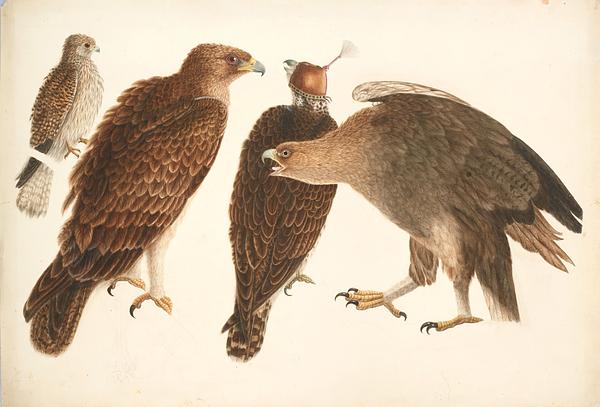This painting with four birds of prey most probably depicts — from left to right — a kestrel,
Falco tinnunculus, a booted eagle,
Hieraaetus pennatus, a peregrine falcon,
Falco peregrinus, and a black kite,
Milvus migrans, or perhaps yet another booted eagle.
[1] Three of the birds are standing on a branch and one is standing on a falcon block — a transverse stick on a spear. These elements were only drawn in lead, however, and never colored. Strangely enough, it is not the trained hunting falcon (peregrine falcon) with the cap that is sitting on the block.
As early as in the reign of the Mughal ruler Jahangir (1605-1627), a number of renditions of Indian plants and animals were made with the intention of creating the most true-to-life depictions possible. A new interest in paintings that provided scientific documentation was once again awakened at the end of the 18th century, especially in Calcutta, where the British commissioned local artists to depict India’s flora and fauna. Some of the most famous and best documented are the works that were made for Lady Mary Impey (
see 38/2008).
The motifs in these late paintings were often isolated from their landscapes, with only the color of the paper as a background, clearly displaying all the details of form and color. This is also true of a number of contemporary human depictions, which also have a sober, documentary, almost ethnological character. (See e.g. the “Fraser paintings,”
58/2007,
59/2007, and
1/2012.)
The painting was brought home by the Danish lawyer, amateur painter, and art collector Benjamin Wolff (1790-1866), who worked for a British trading company in Calcutta between 1817 and 1829. He amassed a small fortune in India and collected both old and contemporary Indian works of art. Because of the quality of the painting, it is most likely an unfinished piece by one of the artists who worked for Lady Impey in around 1780, but it could also have been made a bit later.
